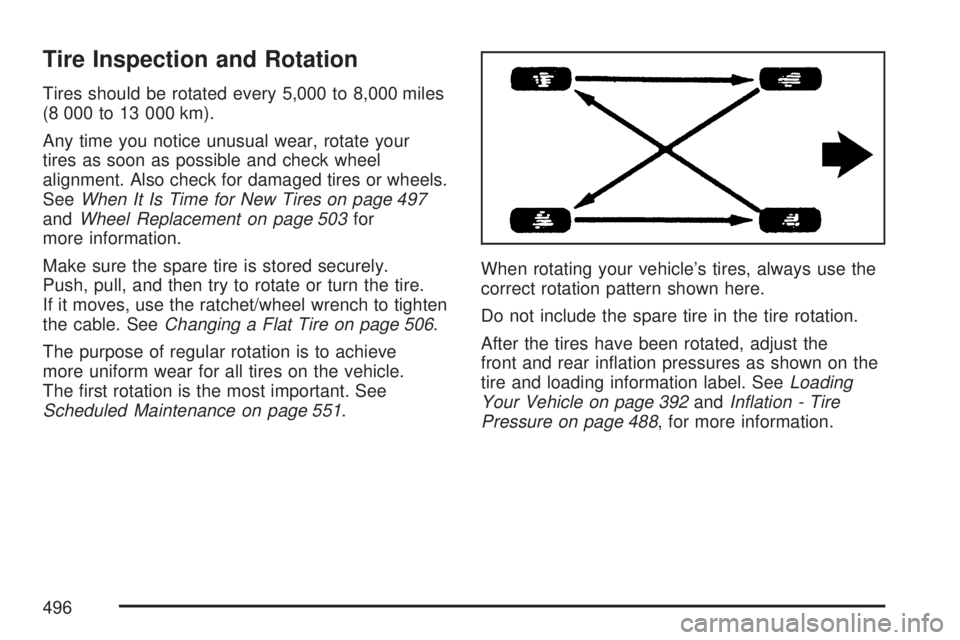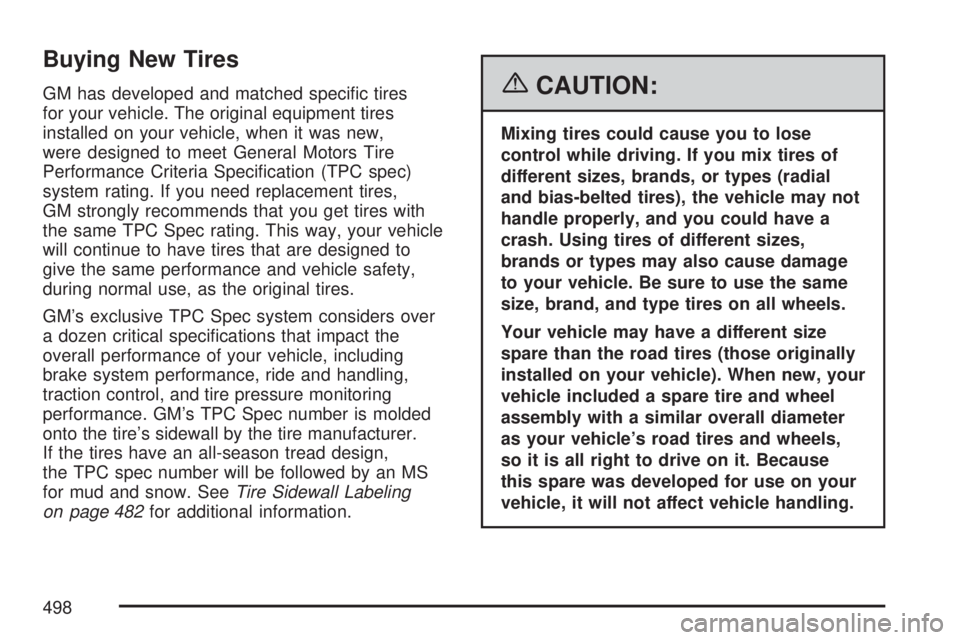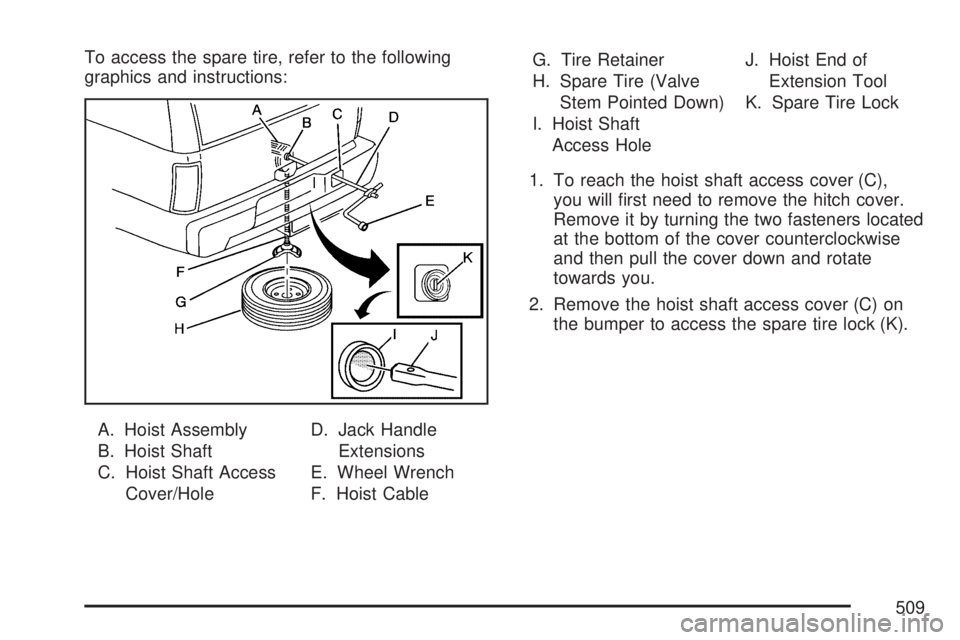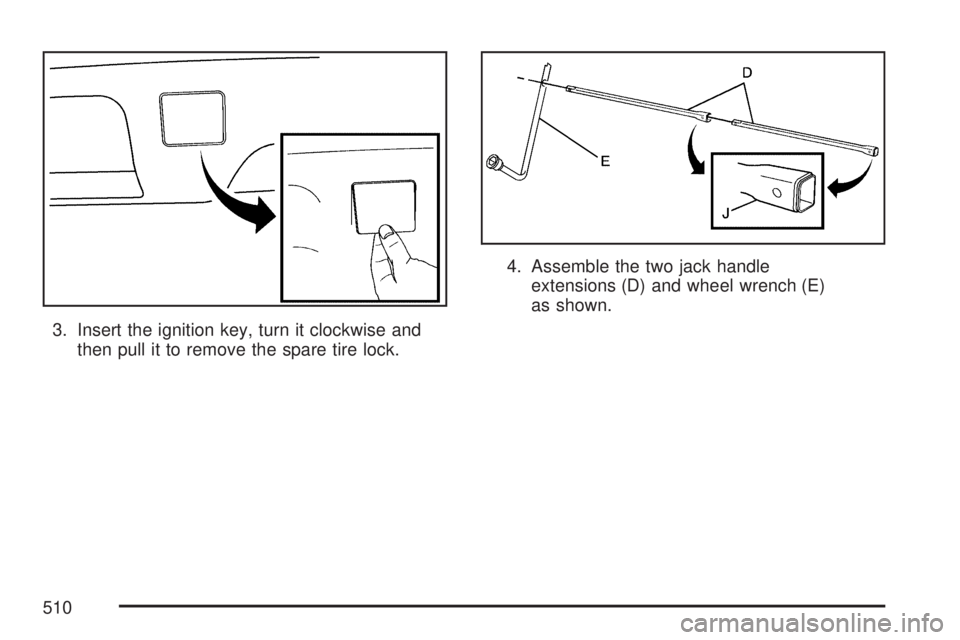2007 GMC YUKON XL DENALI spare wheel
[x] Cancel search: spare wheelPage 418 of 608

Bulb Replacement....................................... 476
Halogen Bulbs........................................... 476
Taillamps, Turn Signal, Stoplamps and
Back-up Lamps...................................... 476
License Plate Lamp................................... 477
Replacement Bulbs................................... 478
Windshield Wiper Blade Replacement....... 478
Tires............................................................ 480
Tire Sidewall Labeling............................... 482
Tire Terminology and De�nitions............... 485
In�ation - Tire Pressure............................. 488
High-Speed Operation............................... 490
Tire Pressure Monitor System................... 490
Tire Inspection and Rotation...................... 496
When It Is Time for New Tires.................. 497
Buying New Tires...................................... 498
Different Size Tires and Wheels................ 500
Uniform Tire Quality Grading..................... 501
Wheel Alignment and Tire Balance............ 502
Wheel Replacement.................................. 503
Tire Chains............................................... 504If a Tire Goes Flat.................................... 505
Changing a Flat Tire................................. 506
Removing the Spare Tire and Tools.......... 507
Removing the Flat Tire and Installing
the Spare Tire....................................... 512
Secondary Latch System........................... 518
Storing a Flat or Spare Tire and Tools...... 522
Spare Tire................................................. 526
Appearance Care........................................ 526
Cleaning the Inside of Your Vehicle.......... 526
Fabric/Carpet............................................. 528
Leather...................................................... 529
Instrument Panel, Vinyl, and Other
Plastic Surfaces..................................... 529
Wood Panels............................................. 530
Speaker Covers........................................ 530
Care of Safety Belts.................................. 530
Weatherstrips............................................ 530
Washing Your Vehicle............................... 530
Cleaning Exterior Lamps/Lenses................ 531
Finish Care............................................... 531
Section 5 Service and Appearance Care
418
Page 490 of 608

High-Speed Operation
{CAUTION:
Driving at high speeds, 100 mph
(160 km/h) or higher, puts an additional
strain on tires. Sustained high-speed
driving causes excessive heat build up
and can cause sudden tire failure. You
could have a crash and you or others
could be killed. Some high-speed rated
tires require in�ation pressure adjustment
for high speed operation. When speed
limits and road conditions are such that
a vehicle can be driven at high speeds,
make sure the tires are rated for high
speed operation, in excellent condition,
and set to the correct cold tire in�ation
pressure for the vehicle load.If your vehicle has P265/65R18 or P275/55R20
size tires and you will be driving at high speeds,
speeds of 100 mph (160 km/h) or higher, set
the cold in�ation pressure to 3 psi (20 kPa) above
the recommended tire pressure shown on the
Tire and Loading Information Label. When you
end this high-speed driving, return the tires to the
cold in�ation pressure shown on the Tire and
Loading Information label. SeeLoading Your
Vehicle on page 392andIn�ation - Tire Pressure
on page 488.
Tire Pressure Monitor System
The Tire Pressure Monitor System (TPMS) uses
radio and sensor technology to check tire pressure
levels. If your vehicle has this feature, sensors
are mounted on each tire and wheel assembly,
except the spare tire. The TPMS sensors monitor
the air pressure in your vehicle’s tires and
transmit tire pressure readings to a receiver
located in the vehicle.
The TPMS is designed to alert the driver, if a low
tire pressure condition exists. If your vehicle has the
Driver Information Center (DIC), the driver may also
check tire pressure levels using the DIC.
490
Page 494 of 608

The TPMS sensor matching process is outlined
below:
1. Set the parking brake.
2. Turn the ignition switch to RUN with the
engine off.
3. Using the DIC, press the vehicle information
button until the PRESS
VTO RELEARN
TIRE POSITIONS message displays.
4. Press the set/reset button. The horn will
sound twice to indicate the TPMS receiver
is ready, and the TIRE LEARNING ACTIVE
message will display.
5. Start with the driver’s side front tire.
6. Remove the valve cap from the valve cap
stem. Activate the TPMS sensor by
increasing or decreasing the tire’s air pressure
for �ve seconds, or until a horn chirp
sounds. The horn chirp, which make take up
to 30 seconds to sound, con�rms that the
sensor identi�cation code has been matched
to this tire and wheel position. To decrease
air-pressure out of a tire you can use the
pointed end of the valve cap, a pencil-style
air pressure gage, or a key.7. Proceed to the passenger’s side front tire, and
repeat the procedure in Step 6.
8. Proceed to the passenger’s side rear tire, and
repeat the procedure in Step 6.
9. Proceed to the driver’s side rear tire, and
repeat the procedure in Step 6.
10. After hearing the con�rming horn chirp for the
driver’s side rear tire, the horn chirp will sound
two more times to signal the tire learning
mode is no longer active. Turn the ignition
switch to LOCK.
11. Set all four tires to the recommended air
pressure level as indicated on the Tire
and Loading Information label.
12. Put the valve caps back on the valve stems
The spare tire does not have a TPMS sensor.
If you replace one of the road tires with the spare,
the SERVICE TIRE MONITOR message will be
displayed on the DIC screen. This message should
go off once you re-install the road tire containing
the TPMS sensor.
494
Page 496 of 608

Tire Inspection and Rotation
Tires should be rotated every 5,000 to 8,000 miles
(8 000 to 13 000 km).
Any time you notice unusual wear, rotate your
tires as soon as possible and check wheel
alignment. Also check for damaged tires or wheels.
SeeWhen It Is Time for New Tires on page 497
andWheel Replacement on page 503for
more information.
Make sure the spare tire is stored securely.
Push, pull, and then try to rotate or turn the tire.
If it moves, use the ratchet/wheel wrench to tighten
the cable. SeeChanging a Flat Tire on page 506.
The purpose of regular rotation is to achieve
more uniform wear for all tires on the vehicle.
The �rst rotation is the most important. See
Scheduled Maintenance on page 551.When rotating your vehicle’s tires, always use the
correct rotation pattern shown here.
Do not include the spare tire in the tire rotation.
After the tires have been rotated, adjust the
front and rear in�ation pressures as shown on the
tire and loading information label. SeeLoading
Your Vehicle on page 392andIn�ation - Tire
Pressure on page 488, for more information.
496
Page 498 of 608

Buying New Tires
GM has developed and matched speci�c tires
for your vehicle. The original equipment tires
installed on your vehicle, when it was new,
were designed to meet General Motors Tire
Performance Criteria Speci�cation (TPC spec)
system rating. If you need replacement tires,
GM strongly recommends that you get tires with
the same TPC Spec rating. This way, your vehicle
will continue to have tires that are designed to
give the same performance and vehicle safety,
during normal use, as the original tires.
GM’s exclusive TPC Spec system considers over
a dozen critical speci�cations that impact the
overall performance of your vehicle, including
brake system performance, ride and handling,
traction control, and tire pressure monitoring
performance. GM’s TPC Spec number is molded
onto the tire’s sidewall by the tire manufacturer.
If the tires have an all-season tread design,
the TPC spec number will be followed by an MS
for mud and snow. SeeTire Sidewall Labeling
on page 482for additional information.{CAUTION:
Mixing tires could cause you to lose
control while driving. If you mix tires of
different sizes, brands, or types (radial
and bias-belted tires), the vehicle may not
handle properly, and you could have a
crash. Using tires of different sizes,
brands or types may also cause damage
to your vehicle. Be sure to use the same
size, brand, and type tires on all wheels.
Your vehicle may have a different size
spare than the road tires (those originally
installed on your vehicle). When new, your
vehicle included a spare tire and wheel
assembly with a similar overall diameter
as your vehicle’s road tires and wheels,
so it is all right to drive on it. Because
this spare was developed for use on your
vehicle, it will not affect vehicle handling.
498
Page 507 of 608

When your vehicle has a �at tire, use the following
example as a guide to assist you in the placement
of wheel blocks.
The following information will tell you next how to
use the jack and change a tire.Removing the Spare Tire and Tools
The equipment you will need to change a �at
tire is stored under the storage tray, which
is located on the driver’s side trim panel (over
the rear wheelhouse).
1. Remove the tray to access the tools by
pulling up on the �nger depression under
the jack symbol.
Regular Wheelbase shown,
Extended Wheelbase similar.
507
Page 509 of 608

To access the spare tire, refer to the following
graphics and instructions:
A. Hoist Assembly
B. Hoist Shaft
C. Hoist Shaft Access
Cover/HoleD. Jack Handle
Extensions
E. Wheel Wrench
F. Hoist CableG. Tire Retainer
H. Spare Tire (Valve
Stem Pointed Down)
I. Hoist Shaft
Access HoleJ. Hoist End of
Extension Tool
K. Spare Tire Lock
1. To reach the hoist shaft access cover (C),
you will �rst need to remove the hitch cover.
Remove it by turning the two fasteners located
at the bottom of the cover counterclockwise
and then pull the cover down and rotate
towards you.
2. Remove the hoist shaft access cover (C) on
the bumper to access the spare tire lock (K).
509
Page 510 of 608

3. Insert the ignition key, turn it clockwise and
then pull it to remove the spare tire lock.4. Assemble the two jack handle
extensions (D) and wheel wrench (E)
as shown.
510